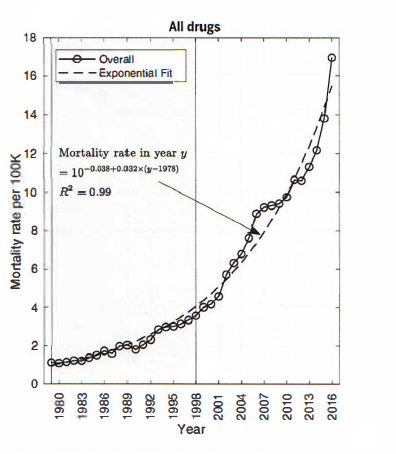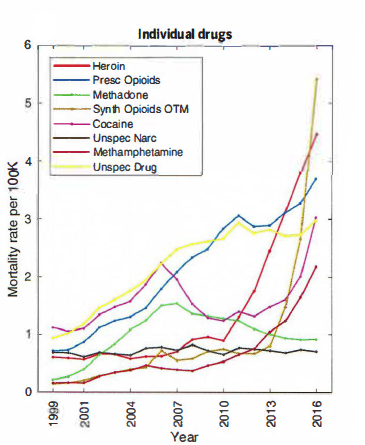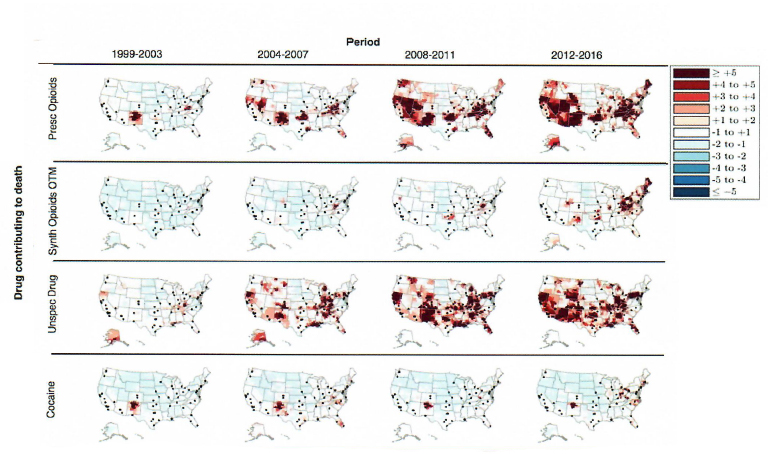As an opioid “solution” completes its trip through Congress, a new article in Science shows that the “overdose crisis” has not only been with us for nearly 40 years but that it is not as monolithic as news bites and hotly worded advocacy suggests. In fact, the data when aggregated presents a much different picture than the tapestry of drugs, demographics, and geography when viewed more closely. Not only does the paper inform us about our current drug “crisis” but serves as a reminder that when summarizing, relevant information may become unintentionally hidden.
The researcher’s dataset comes from death certifications in the National Vital Statistics System using deaths identified as accidental drug poisonings. A change in classification allowed stratification by drug for about 75% of the reported cases. Because all data is imperfect, the dataset is an approximation of a ‘truth.’ The authors report substantial variation on the specificity of drug reporting, that multiple drugs may be present in the setting of the one index drug classified confounding the data, and that classification as ‘accidental drug poisonings’ is not consistently applied nationally. But that said, the study considered nearly 600,000 deaths and uncovers trends that create the aggregate “overdose epidemic” featured in our media.
The view from 50,000 feet – the aggregation
 The graph shows the mortality rate for all drugs beginning in 1979. It shows that overdose deaths have been increasing over that period. Despite a few moments of decrease or increase in overdose deaths, a remarkably smooth exponential growth curve is present. So if the sky is falling, it has been falling for a long time – rising overdose deaths begin at least 20 years before the “opioid crisis.” And if you believe that now that political and economic attention has once again focused on the problem and that it will soon be solved, there is a bridge you might be interested in buying.
The graph shows the mortality rate for all drugs beginning in 1979. It shows that overdose deaths have been increasing over that period. Despite a few moments of decrease or increase in overdose deaths, a remarkably smooth exponential growth curve is present. So if the sky is falling, it has been falling for a long time – rising overdose deaths begin at least 20 years before the “opioid crisis.” And if you believe that now that political and economic attention has once again focused on the problem and that it will soon be solved, there is a bridge you might be interested in buying.
The view from the ground – disaggregation
As it turns out, the overdose epidemic consists of multiple “sub-epidemics,” the index drugs have changed over time. Each drug has its own time, geography and users.  And as the graph demonstrates these “sub-epidemics” are not nearly as predictable as the aggregate would leave you to believe. Here are some highlights from the study
And as the graph demonstrates these “sub-epidemics” are not nearly as predictable as the aggregate would leave you to believe. Here are some highlights from the study
- Prescription opioids initially in the Southwest and Appalachia have likewise been more widely distributed into the Western US, Oklahoma, Florida and New England.
- Fentanyl has followed other opioids as has unspecified index drugs
- Cocaine, while more widespread remains more of an urban drug.
- Only the North Central states have been relatively spared.
- Age and gender matters, the young die from heroin and synthetics, the older from prescription opioids and unspecified drugs. The young are more frequently male, the older female.
Because pictures are often better than words, here is the graph of overdose deaths by time and geography.

Causation
The authors are not foolish enough to attribute causation, and the message is that the media’s version of the drug crisis, is too simplified, that “the overdose epidemic is a composite of multiple sub-epidemics,” is a more appropriate characterization. They go on to suggest that many of the changes we have enacted, reformulating OxyContin, mandatory checking of patient prescriptions, reduction in opioid supplies have been like Whack-a-Mole, reducing opioid deaths while increasing deaths from heroin and synthetics. Or that usage patterns can be altered by outside forces, e.g., the decrease in cocaine production from Columbia may have been a result of both interdiction and diplomacy.
Ultimately, multiple factors impacting multiple drugs and populations go into making the smooth exponential curve of overdose deaths. An “opioid crisis” bill will undoubtedly be helpful to incumbents running for re-election and hopefully to some of the people suffering in our communities. But from a policy point of view, to be effective, we need to direct our interventions at the sub-epidemics and their particular demographics. The current opioid legislation only addresses the composite. To paraphrase former Speaker of the House, Tip O’Neill, all effective treatment is local.
[1] Changing dynamics of the drug overdose epidemic in the United States from 1979 to 2016 Science DOI: 10.1126/science.asul184




